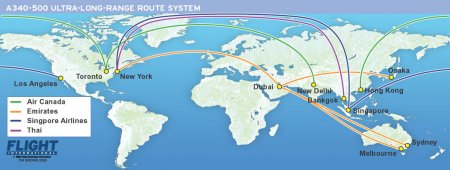With the Boeing 777-200LR not due to enter service until early next year, until now airlines in a hurry to operate ultra-long-range (ULR) flights have had only one place to turn to – Airbus and its A340-500.

Airbus is justly proud of the fact that this derivative of the four-engined, Rolls-Royce Trent 500-powered A340-600 is “the world’s longest-range airliner” in service. This is underlined by Singapore Airlines (SIA), which uses the -500 to operate the world’s longest scheduled air route – the 16,600km (8,970nm) sector between Singapore and New York Newark. These flights, and the sectors between Singapore and Los Angeles, can last 18h, so SIA has configured its -500s with a spacious 181-seat layout compared with the more typical 250-300 seats.
“The A340-500 was launched at the same time as the -600 as a result of airlines like SIA telling us that there was interest in converting some of the latent energy of the -600 into a longer-range, lower-capacity model,” says Airbus director of product marketing, A330/A340, Alan Pardoe. “As far as I can discern now that it is in service, the -500 is doing everything anyone had asked of us from day one.”
The initial -500 model entered service in October 2003 with a 368t (820,000lb) maximum take-off weight (MTOW) and an option to increase that to 372t. This gave the aircraft a range of up to 16,100km with Airbus’s quoted typical load of 313 passengers.
“Range now goes up to 9,000nm with the 380t MTOW version, which comes along towards the end of 2006 or shortly thereafter,” says Pardoe. This higher-weight version uses the strengthened structure of the A340-600 high-gross-weight (HGW) variant, which enters service in the second quarter of next year with launch operators Emirates and Qatar Airways.
“The HGW -500 will be identical to today’s aircraft other than the MTOW increase. We do not have, nor do we propose to have, auxiliary fuel in that aircraft,” adds Pardoe.
The A340-500 was launched three years before the 777-200LR/300ER family and entered service some 30 months ahead of its ULR rival, enabling this “cut and shut” derivative of the A340-600 to capture the bulk of the relatively tiny ULR market until recently. However, Boeing has fought back and concluded several deals as part of a 777/787 double act, including Air Canada and Air India – orders that the manufacturer has yet to record in its firm backlog.
Eighteen A340-500s have been delivered to five customers – Air Canada (two), Emirates (eight), SIA (five) and Thai Airways International (two), as well as a single head of state aircraft operated by Qatar Airways for the country’s government.
However, compared with its more mainstream big sister the A340-600, Pardoe concedes that -500 sales have been “comfortable” rather than “massive”, with only eight more remaining on order. And he is not convinced that either the -500 or its US ULR rival have glittering future market prospects given recent fuel price and aircraft developments. “Our notional benchmark for ultra-long-range missions is 8,000nm and up, and there is a question as to the size of the ULR market going forward,” he says.
According to Pardoe, two key developments since the A340-500 was launched have changed the dynamics of the ULR market: Firstly there has been an upward spiral in the cost of fuel, “which has to have changed the economics of ULR as on these missions you are carrying fuel to burn fuel at the end of the flight”.
Pardoe says the second factor is that until recently the definition of the specialist ULR aircraft models was more clear-cut, but this is not the case now as “the rest of the herd has caught up in terms of range”.
Not only are the longer-range, increased-weight versions of the A340-600 and 777-300ER “taking a bigger bite out of the bottom of the A340-500/777-200LR market”, but “the A350-800 and 787-8 will get beyond the nominal 8,000nm range bar and could be classified as ULR aircraft”, says Pardoe.
Pardoe says the rash of new aircraft capable of breaking into the ULR category means that “the airlines are faced with a little bit more decision making on what serves which market best. I think the airlines will ‘pause to reflect’ on the fuel efficiency of the new A350 against anything that is flying today – it will deliver mind-boggling efficiency.”
In light of these developments, Pardoe believes that the airlines will ask: “Do the economics of ULR operations stack up as well as previously at the higher fuel price?” – and he believes that they will start to look at other alternatives to serve this kind of market. However, he is quick to point out that evaluations of the new ULR twins against the four-engined A340-500 go beyond simple cost per seat equations as “it gets back into the good old domain of ETOPS and Polar routes, etc”.
Pardoe says the bottom line is that the A340-500 and 777-200LR no longer have the ULR marketplace to themselves: “I’d be suspicious as to the size of the market going forward for either aircraft. If I was the ‘other guy’, I’d be very nervous bringing a product into market maybe after the stable door has shut… I’d be surprised if [Boeing] sold a lot of aircraft in this category.”
MAX KINGSLEY-JONES/TOULOUSE
Source: Flight International



















